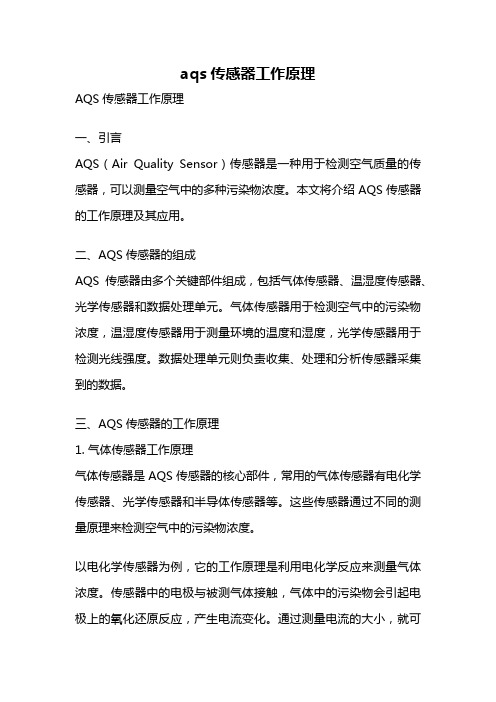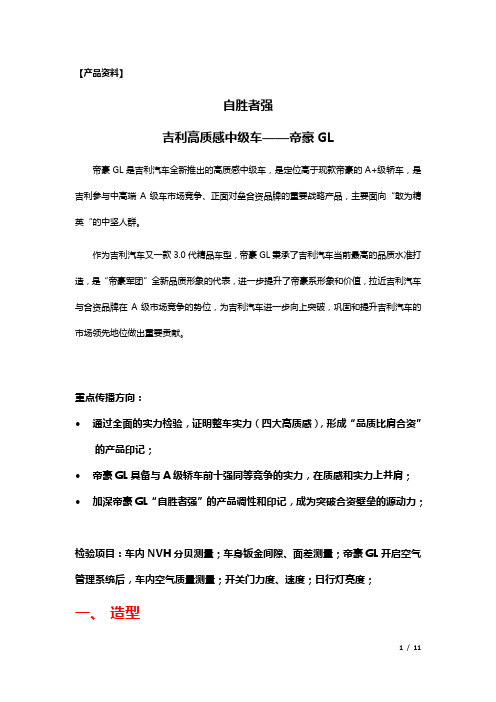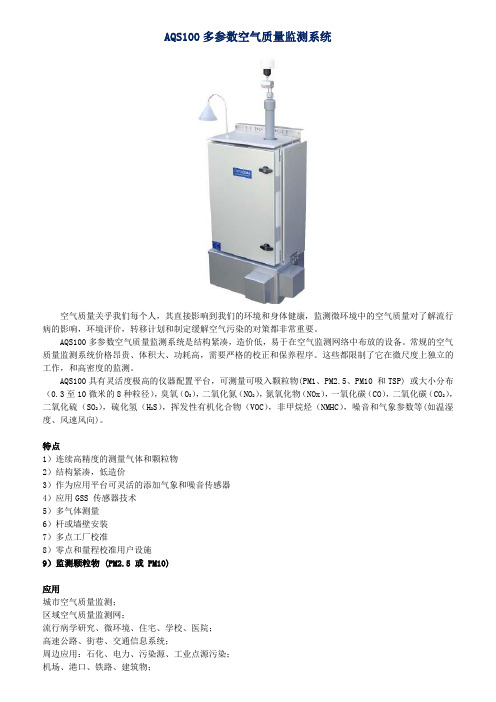AQS汽车外空气质量传感器应用指南
车联网常用术语大全

车联网常用术语大全“车联网”热度居高不下。
作为一个网络连接平台,车联网有着许多术语。
这篇文章帮大家梳理、解释一下常见的车联网术语。
1、车联网(internet of vehicles):利用现代通信技术构建的车与人、车、路、云平台、环境、服务等之间的网络连接平台。
2、车联网路侧设施(roadside facilities for internet of vehicles):加载通信模组和位置、方向、状态等传感器,能够与自动驾驶车辆通信、与云平台互联互通的路侧设施。
3、数字化车联网路侧设施(digital roadside facilities for internet of vehicles):采用数字化方式将地理信息、交通管理信息、环境状态信息等内容传递给自动驾驶车辆和云平台的车联网路侧设施。
4、静态路侧设施(roadside facilities of no variable signs):信息不可变的车联网路侧设施。
5、动态路侧设施(roadside facilities of variable signs):信息部分或全部可变的车联网路侧设施。
6、数据链单元(smart data chain unit):采用现代的通信和互联网等技术,通过对车联网环境下道路各节点的通信集成、数据集成、算法集成,实现各类数据的充分融合、高效传输和主动控制的设备。
7、满载工作时间(full capacity work time):采用太阳能供电的设备,在断开充电回路的条件下,完全充电状态的蓄电池组可以保证设备连续有效工作的时间。
8、半载工作时间(half capacity work time):采用太阳能供电的设备,蓄电池放电至过放保护状态,断开负载,在标准测试条件下对蓄电池充电8h,连续负载后设备连续有效工作的时间。
9、行人过街智能预警系统(intelligent warning system for pedestrian crossing):一种设置于无交通信号灯控制的人行横道线处,通过采集过街行人和车辆数据,向行人或车辆预警的系统。
汽车日常使用常识上路前检查车况

❖ 而光触媒净化系统实际上就相当于在空调或 车内安装固体催化剂,在光照(包括可见光和 紫外线)作用下,将房间或车内的甲醛、苯、 二甲苯等有害物质分解为二氧化碳、氮气和 水等无害物质。
❖ 当然,多数汽车都没有空气净化系统,业内 人士建议有条件的车主可以购买一个车内空 气净化设备,它能消除车内的异味、有毒有 害气体、细菌病毒等车内污染。
❖ 刘师傅介绍说,外循环状态是利用风机将车外的空 气抽吸到车内,也就是说,车外与车内的气道是流 通的,风扇打出的风来自车外,即使不开风机,车 辆行驶中仍然有气流吸入到车内,补充车内的新鲜 空气。因此,在雾霾天气下,即使关闭门窗,高浓 度的悬浮污染物或可吸入颗粒物也能通过外循环进 入车内。所以,在雾霾天,车主不仅需要关闭门窗, 而且应尽量开启车内空调的内循环系统。“跑高速 或在车内时间太久的话,再开一会儿外循环,让外 部的空气进来一些。”
定期清洗更换汽车的“口罩”
❖ 在雾霾较重时,不少市民常常会给自己戴上 口罩,用过之后要么及时清洗,要么就直接 扔掉。而汽车其实也有一个“口罩”,那就 是发动机的进气滤芯和空调滤芯。这两样物 件就如同汽车的空气保护伞一样,能有效减 少污染物通过采暖通风和空调系统进入车内, 防止车主吸入对身体有害的污染物。
仔细检查你看不到的部位
❖ 车主大多爱护自己的座驾,并注重其维修养 护。但每辆车总会有一些我们触及不到或者 想不到的保养部位。这些部位虽然难触及, 但对行车安全却有着至关重要的作用,或者 能影响汽车的制动性、油耗,有的甚至影响 车主的生命安全。
点火线:老化会影响车辆动力性和油
耗
❖ 火花塞相信大家都知道,也有的车主能够自己动手 更换火花塞,但与之相比,点火线就很少被大家关 注了。有的车主很纳闷,为什么自己的车没什么毛 病,但就是不爱着火,行驶油耗变高,动力差,如 果不是其他原因引起的话,建议您对点火线进行一 下检查吧。点火线两端连接分电器和火花塞,是汽 车行驶中传递给发动机电火花的唯一路径,由于使 用频率高以及工作环境比较恶劣,容易出现老化、 破损等现象,造成点火能量不足,严重影响车辆动 力性和油耗。建议车辆每两万公里更换点火线。
aqs传感器工作原理

aqs传感器工作原理AQS传感器工作原理一、引言AQS(Air Quality Sensor)传感器是一种用于检测空气质量的传感器,可以测量空气中的多种污染物浓度。
本文将介绍AQS传感器的工作原理及其应用。
二、AQS传感器的组成AQS传感器由多个关键部件组成,包括气体传感器、温湿度传感器、光学传感器和数据处理单元。
气体传感器用于检测空气中的污染物浓度,温湿度传感器用于测量环境的温度和湿度,光学传感器用于检测光线强度。
数据处理单元则负责收集、处理和分析传感器采集到的数据。
三、AQS传感器的工作原理1. 气体传感器工作原理气体传感器是AQS传感器的核心部件,常用的气体传感器有电化学传感器、光学传感器和半导体传感器等。
这些传感器通过不同的测量原理来检测空气中的污染物浓度。
以电化学传感器为例,它的工作原理是利用电化学反应来测量气体浓度。
传感器中的电极与被测气体接触,气体中的污染物会引起电极上的氧化还原反应,产生电流变化。
通过测量电流的大小,就可以得到气体的浓度信息。
2. 温湿度传感器工作原理温湿度传感器常用的原理有电容式、电阻式和电感式等。
以电容式传感器为例,它利用材料在不同温度或湿度下的电容变化来测量环境的温度和湿度。
电容式传感器由两个电极和介质组成,当介质的温度或湿度发生变化时,电容值也会发生变化。
通过测量电容的变化,就可以得到环境的温度和湿度信息。
3. 光学传感器工作原理光学传感器常用的原理有散射原理和吸收原理等。
以散射原理为例,它利用光在空气中的散射特性来测量空气中的颗粒物浓度。
光学传感器发射一束光线,当光线遇到空气中的颗粒物时,会发生散射现象。
通过测量光线的散射强度,就可以得到空气中颗粒物的浓度信息。
四、AQS传感器的应用AQS传感器广泛应用于室内空气质量监测、智能家居、环境污染监测等领域。
通过监测空气中的污染物浓度,可以及时采取措施改善室内空气质量,保障人们的健康。
在室内空气质量监测方面,AQS传感器可以测量各种有害气体的浓度,如甲醛、二氧化碳和挥发性有机物等。
北京现代NF空调中文讲义

Battery IG2
M
Blower Motor Measure voltage
v
C High Speed Blower Relay
Power TR
CONTROLLER
B E
v
Measure voltage: Variable (up/down blower speed switch)
* Caution: Do not pull off the TR during blower operation.
C High Speed Blower Relay
Power TR
CONTROLLER
1 step 2 step 3 step 4 step 5 step 6 step 7 step 8 step
B E
鼓风机速度控制置
④功率TR 检查方法 2
Blower Relay
25
* Condition: IG ON, FATC OFF
空调系统
内 容
▶ 规格说明 ▶ 安装示意图 ▶ 制冷回路 ▼ 发动机室内的部件
- 冷凝器 - 空调泵
2
▼ 传感器
- APT传感器 - 蒸发箱温度传感器 - 室内温度传感器 - 光照度传感器 - 外界温度传感器 - AQS - 湿度传感器
▼ 室内部件
- 暖风加热器总称 - 蒸发器总称 * 空气滤清器 * 鼓风机电机 * 功率晶体管 * 鼓风机继电器
Evaporator Blower unit unit
NF HVAC UNIT
Blower unit
HVAC unit
系统比较
6
FATC 控制单元
手动控制单元
系统规格
项目 Type 空调泵 Capacity Oil 类型 皮带轮 皮带轮图标 冷凝器 APT 传感器 安全阀 类型 类型 类型 类型 制冷剂 数量(g) 550 ← ← 120mm Sub Cool Multi step Block R-134a ← ← ← ← ← 125mm ← ← ← ← θ 2.0 VS (可变斜盘式) 180cc PAG 150g 6PK θ 2.4 ← ← ← ← λ3.3 ← ← ← ←
帝豪GL 实力检验官 产品资料0907

【产品资料】自胜者强吉利高质感中级车——帝豪GL帝豪GL是吉利汽车全新推出的高质感中级车,是定位高于现款帝豪的A+级轿车,是吉利参与中高端A级车市场竞争、正面对垒合资品牌的重要战略产品,主要面向“敢为精英“的中坚人群。
作为吉利汽车又一款3.0代精品车型,帝豪GL秉承了吉利汽车当前最高的品质水准打造,是“帝豪军团”全新品质形象的代表,进一步提升了帝豪系形象和价值,拉近吉利汽车与合资品牌在A级市场竞争的势位,为吉利汽车进一步向上突破,巩固和提升吉利汽车的市场领先地位做出重要贡献。
重点传播方向:•通过全面的实力检验,证明整车实力(四大高质感),形成“品质比肩合资”的产品印记;•帝豪GL具备与A级轿车前十强同等竞争的实力,在质感和实力上并肩;•加深帝豪GL“自胜者强”的产品调性和印记,成为突破合资壁垒的源动力;检验项目:车内NVH分贝测量;车身钣金间隙、面差测量;帝豪GL开启空气管理系统后,车内空气质量测量;开关门力度、速度;日行灯亮度;一、造型1、外观:简雅拟态美学设计➢前脸:“雄鹰式”前脸“盾形”水滴回纹涟漪前格栅采用“悬浮式”处理,与鹰眼远近光投射大灯连成一体,勾勒出“雄鹰式”前脸。
宽大前格栅充满力量美感,伴有晶钻式LED日行灯点缀。
凌厉气势中不乏潮流动感。
a)悬浮式水滴涟漪上格栅:传承家族式设计,更具识别度,同时帝豪GL独创悬浮式格栅设计,独具未来科技感;侧面造型如鹰喙般凌厉中兼有动感。
b)“鲨鱼嘴”下格栅:下格栅采用镀铬包围,充满力量美感,在大气舒展中展示气势和活力;c)鹰眼式投射前大灯:秉承吉利最新科技,远近光一体,采用鹰眼仿生,将功能与艺术完美结合,充满了时尚与科技感;具有自动开启和电动调节功能;d)LED日间行车灯:时尚精致,能提高车辆被识别率,降低事故发生的概率;➢侧身:“豹跃式”流线车身修长且有韧劲的侧身特征线、内凹式双侧腰线,以及Fastback快背式设计,让帝豪GL侧面呈现猎豹奔袭跳跃式的视觉张力。
(2021年整理)汽车术语缩写

汽车术语缩写编辑整理:尊敬的读者朋友们:这里是精品文档编辑中心,本文档内容是由我和我的同事精心编辑整理后发布的,发布之前我们对文中内容进行仔细校对,但是难免会有疏漏的地方,但是任然希望(汽车术语缩写)的内容能够给您的工作和学习带来便利。
同时也真诚的希望收到您的建议和反馈,这将是我们进步的源泉,前进的动力。
本文可编辑可修改,如果觉得对您有帮助请收藏以便随时查阅,最后祝您生活愉快业绩进步,以下为汽车术语缩写的全部内容。
电控燃油喷射:EFI废气再循环:EGR防抱死:ABS等等.。
,AAFS:自适应照明系统主动前轮转向系统AYC:主动偏航控制系统主动横摆控制系统ASC:主动式稳定控制系统自动稳定和牵引力控制车轮打滑控制ABS:防抱死制动系统ASR:防滑系统ASL:音量自动调节系统排档自动锁定装置AUX:音频输入端口ADS:自适应减振系统ACC:自适应巡航控制系统车距感应式定速巡航控制系统AWD:全时四轮驱动系统ACD:主动中央差速器AMT:电子自动变速箱电控机械式自动变速器All-Speed TCS:全速段牵引力控制系统ACIS:电子控制进气流程系统丰田可变进气歧管系统ABD:自动制动差速系统AGF:亚洲吉利方程式国际公开赛AUTO:自动切换四驱ASC+T:自动稳定和牵引力控制系统ABC:主动车身控制AXCR:亚洲越野拉力赛ARP:主动防侧翻保护AFM:动态燃油管理系统APEAL:新车满意度中国汽车性能、运行和设计调研AT:自动变速器Asian festival of speed:亚洲赛车节AOD:电子控制按需传动装置AACN:全自动撞车通报系统ARTS:智能安全气囊系统AWS:后撞头颈保护系统AIAC:奥迪国际广告大赛AVS:适应式可变悬架系统Audi AAA:奥迪认证轿车ATA:防盗警报系统ALS:自动车身平衡系统ARS:防滑系统ASPS:防潜滑保护系统ASS:自适应座椅系统AQS:空气质量系统AVCS:主动气门控制系统ASF:奥迪全铝车身框架结构A-TRC:主动牵引力控制系统AHC:油压式自动车高调整AMG:快速换档自动变速箱AHS2:“双模”完全混合动力系统AI:人工智能换档控制APRC:亚太汽车拉力锦标赛ARTS:自适应限制保护技术系统ACU:安全气囊系统控制单元AP:恒时全轮驱动AZ:接通式全轮驱动ASM:动态稳定系统AS:转向臂APC:预喷量控制Active Light Function:主动灯光功能ACE:高级兼容性设计Audi Space Frame:奥迪全铝车身技术AWC:全轮控制系统ASTC:主动式稳定性和牵引力控制系统BBA:紧急制动辅助系统BEST:欧盟生物乙醇推广项目Brake Energy Regeneration:制动能量回收系统BLIS:盲区信息系统BAS:制动助力辅助装置BRIDGESTONE:普利司通轮胎Biometric immobilizer:生物防盗系统BCI:蓄电池国际协会国际电池大会BAR:大气压BDC:下止点BBDC:北京奔驰—戴克汽车新工厂B:水平对置式排列多缸发动机BF:钢板弹簧悬架BCM:车身控制模块BCS:博世汽车专业维修网络BMBS:爆胎监测与制动系统BFCEC:北京福田康明斯发动机有限公司CCCS:智能定速巡航控制系统CSI:中国售后服务满意度调研CVVT:连续可调气门正时CVT:无级变速器CZIP:清洁区域内部组件CCC:全国汽车场地锦标赛CVTC:连续可变气门正时机构连续可变配气正时CHAC:本田汽车(中国)有限公司CAE:电脑辅助工程CAM:电脑辅助制造CBC:弯道制动控制系统转弯防滑系统CNG:压缩天然气CSC:全国汽车超级短道拉力赛CDC:连续减振控制C—NCAP:中国新车评价规程CTIS:悍马中央轮胎充气系统C1:超级赛车劲爆秀CCA:冷启动电池CRDI:电控直喷共轨柴油机高压共轨柴油直喷系统CFK:碳纤维合成材料Child Protection:儿童保护CPU:微处理器CZ3:3门轿车C3P技术:整合电脑、辅助设计、工程、制造数据库技术CATS:连续调整循迹系统 CRV:紧凑休闲车CUV:杂交车CZT:增压车型CTS:水温传感器CKP:曲轴位置传感器CC:巡航系统CFD:计算流力仿真CRC:全国汽车拉力锦标赛Cuprobraze Alliance:铜硬钎焊技术联盟Cuprobraze Technology:铜硬钎焊技术CCD:连续控制阻尼系统Curb weight:汽车整备质量Cross weight:汽车总质量CKD:进口散件组装DDSC:动态稳定控制系统DSP :动态换档程序DSTC:动态稳定和牵引力控制系统动态循迹稳定控制系统DOHC:双顶置凸轮轴DSG:双离合无级变速箱直接档位变速器DCS:动态稳定系统DUNLOP:邓禄普轮胎DBW:电子油门DSR:下坡速度控制系统DATC:数位式防盗控制系统DLS:差速器锁定系统DSA:动态稳定辅助系统DAC:下山辅助系统DDC:动态驾驶控制程序DIS:无分电器点火系统DLI:丰田无分电器点火系统DSC3:第三代动态稳定控制程序DOD:随选排量Dynamic Drive:主动式稳定杆D:共轨柴油发动机DD:缸内直喷式柴油发动机缸内直喷式发动机(分层燃烧|均质燃烧) 德迪戎式独立悬架后桥DQL:双横向摆臂DB:减振器支柱DS:扭力杆Delphi Common Rail:德尔福柴油共轨系统DTC:动态牵引力控制系统DHS:动态操纵系统DRL:白天行车灯Doppel Vanos:完全可变正时调节DPF:柴油颗粒过滤器EECT-I:智能电子控制自动变速系统ESP:电子稳定系统EBD:电子制动力分配系统EDL:电子差速锁EGR:废弃再循环系统EFI:电子燃油喷射控制系统EVA:紧急制动辅助系统EPS:电子感应式动力转向电控转向助力系统EHPS:电控液压动力转向ECU:电控单元EMS:发动机管理系统ECC:电子气候控制ETCS-I:智能电子节气门控制系统EBA:电控辅助制动系统紧急制动辅助系统ECM:防眩电子内后视镜电子控制组件(模块)EEVC:欧洲车辆安全促进委员会EPAS:电动助力转向EMV:多功能显示操控系统EHPAS:电子液压动力辅助系统ETC:路虎牵引力控制系统动力控制与弥补系统电子节流阀控制系统ELSD:电子限滑差速锁ECVT:无级自动变速器ED:缸内直喷式汽油发动机EM:多点喷射汽油发动机ES:单点喷射汽油发动机ESP Plus:增强型电子稳定程序EPB:标准电子手刹电子停车制动系统ESC:能量吸收式方向盘柱电子动态稳定程序ETS:电子循迹支援系统ECT:电子控制自动变速系统EBD:电子制动力分配系统EHB:电子液压制动装置EGO:排气含氧量EBCM:电子制动控制组件EECS|EEC:电控发动机ESA:电控点火装置ENG:发动机ECS:电子悬架ECO:经济曲线EVM:压力调节电磁阀EVLV:变矩器锁止电磁阀EPDE:流量调节电磁阀ESP Plus:增强型电子稳定程序EDS:电子差速锁ERM:防侧倾系统FFSI:汽油直喷发动机汽油分层直喷技术FBS:衰减制动辅助FPS:防火系统FF:前置前驱Four-C:连续调整底盘概念系统Formula 1:世界一级方程式锦标赛FHI:富士重工FR:前置后驱FFS:福特折叠系统FCV:燃料电池概念车Front Impact :正面碰撞FAP:粒子过滤装置FWD:前驱左右对称驱动总成FRV:多功能休闲车FIA:国际汽联FI:前置纵向发动机FQ:前置横向发动机FB:弹性支柱Full-time ALL:全时四驱GGPS:全球卫星定位系统GOODYEAR:固特异轮胎GT:世界超级跑车锦标赛GDI:汽油直喷GF:橡胶弹簧悬架 GLOBAL SMALL STYLISH SALOON:全球小型时尚三厢车HHPS:液压动力转向HBA:可液压制动辅助HDC:坡道缓降控制系统下坡控制系统HRV:两厢掀背休闲车HMI:人机交流系统HSLA:高强度低合金钢HSD:混合动力技术概念HSA:起步辅助装置HUD:抬头显示系统HPI:汽油直喷发动机HAC:上山辅助系统坡道起步控制系统HC:碳氢化合物Haldex:智能四轮全时四驱系统HID:自动开闭双氙气大灯高强度远近光照明大灯HI:后置纵向发动机HQ:后置横向发动机HP:液气悬架阻尼HF:液压悬架Hankook:韩泰轮胎IICC:智能巡航控制系统IAQS:内部空气质量系统IDIS:智能驾驶信息系统I-DSI:双火花塞点火I—VTEC:可变气门配气相位和气门升程电子控制系统Instant Traction:即时牵引控制Intelligent Light System:智能照明系统ITP:智能化热系统IMES:电气系统智能管理IIHS:美国高速公路安全保险协会Intelli Beam:灯光高度自动调节IFC:国际方程式冠军赛IQS:美国新车质量调查IMA:混合动力系统ITS:智能交通系统IASCA:汽车音响委员会IDS:互动式驾驶系统ILS:智能照明系统ISC:怠速控制IC:膨胀气帘IDL:怠速触电I—Drive:智能集成化操作系统ICM:点火控制模块Intelligent Light System:智能灯光系统ITARDA:日本交通事故综合分析中心IVDC:交互式车身动态控制系统JKLLSD:防滑差速度LED:发光二极管LOCK:锁止四驱LPG:明仕单燃料车明仕双燃料车液化石油气LDW:车道偏离警示系统LDA:气动供油量调节装置LVA:供气组件LL:纵向摆臂LF:空气弹簧悬架Low Pressure System:低压系统LATCH:儿童座椅固定系统MMRC:主动电磁感应悬架系统MPS:多功能轿车MDS:多排量系统MICHELIN:米其林轮胎MSR:发动机阻力扭矩控制系统MUV:多用途轿车MSLA:中强度低合金钢MMI:多媒体交互系统MT:手动变速器MPV:微型乘用厢型车MBA:机械式制动助力器MPW :都市多功能车MAP:进气管绝对压力点火提前角控制脉谱图进气压力传感器空气流量计MASR:发动机介入的牵引力控制MAF:空气流量传感器MTR:转速传感器MIL:故障指示灯Multi-Crossover:多功能跨界休旅车Multitronic:多极子自动变速器MI:中置纵向发动机MQ:中置横向发动机MA:机械增压ML:多导向轴MES:汽车制造执行系统MIVEC:智能可变气门正时与升程控制系统NNHTSA:美国高速公路安全管理局NICS:可变进气歧管长度NCAP:欧洲新车评估体系Nivomat:车身自动水平调节系统电子液压调节系统NOR:常规模式NVH:噪音和振动减轻装置NOS:氧化氮气增压系统OOBD:车载自诊断系统OHB:优化液压制动OHV:顶置气门,侧置凸轮轴OD档:超速档OHC:顶置气门,上置凸轮轴PPASM:保时捷主动悬架管理系统PSM:保时捷稳定管理系统车身动态稳定控制系统联机PTM:保时捷牵引力控制管理系统循迹控制管理系统PRESAFE:预防性安全系统PCC:人车沟通系统遥控系统PODS:前排座椅乘坐感应系统PCCB:保时捷陶瓷复合制动系统PIM:专案信息管理系统PATS:电子防盗系统PDC:电子泊车距离控制器自动侦测停车引导系统驻车距离警示系统PGM-FI:智能控制燃油喷射Pole Test:圆柱碰撞Pedestrian Impact Test:行人碰撞PTS:停车距离探测 PCV:曲轴箱强制通风PCV阀:曲轴箱通风单向阀PCM:动力控制模块保时捷通讯管理系统PWR:动力模式PSI:胎压PD:泵喷嘴PDCC:保时捷动态底盘控制系统PAD:前排乘客侧安全气囊助手席安全气囊禁止Part—time:兼时四驱PEM:燃油泵电子模块QQLT:检查机油液面高度、温度和品质的传感器 (Quality Level Temperature)Quattro:全时四驱系统QL:横向摆臂QS:横向稳定杆RRSC:防翻滚稳定系统RAB:即时警报制动ROM:防车身侧倾翻滚系统RISE:强化安全碰撞RSCA:翻滚感应气囊保护RR:后置后驱RFT:可缺气行驶轮胎RSM:雷诺三星汽车公司RDK:轮胎压力控制系统RWD:后驱RSS:道路感应系统RC:蓄电池的储备容量Ray Tracing:即时光线追踪技术R:直列多缸排列发动机RES:遥控启动键Real—time:适时四驱SSFS:灵活燃料技术SAE:美国汽车工程师协会SRS:安全气囊SH-AWD:四轮驱动力自由控制系统SMG:顺序手动变速器Symmetrical AWD:左右对称全时四轮驱动系统SBW:线控转向STC:上海天马山赛车场SIPS:侧撞安全保护系统SUV:运动型多功能车SBC:电子感应制动系统电子液压制动装置Servotronic:随速转向助力系统SAIC:上海汽车工业集团公司SSUV:超级SUVSSI:中国汽车销售满意度指数SID:行车信息显示系统Side Impact:侧面碰撞STI:斯巴鲁国际技术部SDSB:车门防撞钢梁SLH:自动锁定车轴心S-AWC:超级四轮控制系统SSS:速度感应式转向系统SVT:可变气门正时系统SCR技术:选择性催化还原降解技术SCCA:全美运动轿车俱乐部SS4—11:超选四轮驱动SPORT:运动曲线SACHS:气液双筒式避震系统SOHC:单顶置凸轮轴SAHR:主动性头枕SDI:自然吸气式超柴油发动机ST:无级自动变速器SL:斜置摆臂SA:整体式车桥SF:螺旋弹簧悬架S:盘式制动SI:内通风盘式制动SFI:连续多点燃油喷射发动机SF\CD:汽油\柴油通用机油SAV:运动型多功能车SAIS:上海汽车信息产业投资有限公司SUBARU BOXER:斯巴鲁水平对置发动机TTCL:牵引力控制系统TCS:循迹防滑系统TRC:主动牵引力系统驱动防滑控制系统TDI:轮胎故障监测器涡轮增压直喷柴油机TSA:拖车稳定辅助TPMS:轮胎压力报警系统胎压监测系统TC Plus:增强型牵引力控制系统TDO:扭力分配系统TCU:自动变速箱的控制单元TRACS:循迹控制系统TDC:上止点TBI:(化油器体的)节气门喷射TPS:节气门体和节气门位置传感器丰田生产体系Traffic Navigator :道路讯息告知系统Tiptronic:手动换档程序TFP:手控阀位置油压开关TNR:噪音控制系统Tiptronic:轻触子—自动变速器TDI:Turbo直喷式柴油发动机TA:turbo涡轮增压T:鼓式制动TCM:变速器控制单元TSI:双增压Turn-By—Turn Navigation:远程车辆诊断和逐向道路导航THERMATIC:四区域自动恒温控制系统UULEV:超低排放车辆UAA:联合汽车俱乐部VVDC:车辆动态控制系统VTG:可变几何涡轮增压系统VIN:车辆识别代码VSA:车辆稳定性辅助装置动态稳定控制系统Volvo Safety Center:沃尔沃安全中心VSC:车辆稳定控制系统汽车防滑控制系统VDIM:汽车动态综合管理系统VTEC:可变气门正时及升程电子控制系统VCM:可变气缸系统VVT—I:智能可变正时系统进出气门双向正式智能可变系统 VICS:可变惯性进气系统VGRS:可变齿比转向系统VSES:动态稳定系统Variable Turbine Geometry:可变几何涡轮增压系统VIS:可变进气歧管系统VCU:黏性耦合差速器VDS:汽车可靠性调查VCC:多元化概念车VTI-S:侧安全气帘VVT:内置可变气门正时系统VDI阀:可变动态进气阀VGIS:可变进气歧管系统VTD:可变扭矩分配系统VE:容积效率Valvetronic:无级可变电子气门控制完全可变气门控制机构VSS:车速传感器VGT:可变截面涡轮增压系统V:V型气缸排列发动机VL:复合稳定杆式悬架后桥VTCS:可变涡轮控制系统VAD:可变进气道系统VANOS:凸轮轴无级调节技术WWRC:世界汽车拉力锦标赛WHIPS:头颈部安全保护系统防暴冲系统WelcomingLight:自动迎宾照明系统WTCC:世界房车锦标赛WOT:节气门全开WA:汪克尔转子发动机W:W型汽缸排列发动机XYZZBC:笼型车体概念ZEV:零废气排放数字4WD:四轮驱动4C:四区域独立可调空调4WS:四轮转向4MATIC:全轮驱动系统4HLC:高速四轮驱动配中央差速器4H:高速四驱4L:低速四驱4LC:低速锁止四驱AFM 空气流量计AIC 空气喷射控制AIS 空气喷射系统ALT 海拔开关A/M 自动—手动ASC 自动稳定性控制AT(A/T)自动变速器ATS 空气温度传感器B+ 蓄电池正极BPA 旁通空气BPS 大气压力传感器BTSC 上止点前CCS 巡航控制系统CFI 中央燃油喷射CFI 连续燃油喷射CID 判缸传感器CIS (燃油)连续喷射系统CIS气缸识别传感器(判缸传感器) CNG 天然气CNGV 天然气汽车CPS 轮轴位置传感器CPS 曲轴位置传感器CPU 中央处理器CTP 节气门关闭位置CTS 冷却液温度传感器CYL 气缸(传感器)DC 直流电DI 分电器点火DIS 无分电器点火系统DIAGN 诊断DLC 数据线接DLI 无分电器点火DTC 诊断故障码ECA 电子控制点火提前ECCA发动机集中控制系统ECD 电子控制柴油机ECM 发动机控制模块ECT 电控变速器ECT 发动机机冷却液温度ECU 电子控制单元(电脑)EDS 柴油机电控系EEC 发动机电子控制EFI 电控燃油喷射EGI 电控汽油喷射EGR 废气再循环EIS 电子点火系统EPA 环保机构ER 发动机运转ESA 电子点火提前EST 电子点火正时EUT 电子控制燃油喷射系统EVAP燃油蒸气排放控制装置FP 燃油泵FTMP 燃油温度FFM 热膜式空气质量流量计HAC 海拔(高度)补偿阀HEI 高能点火HEUI液压电子控制燃油喷射系统HIC 热怠速空气补偿阀HO2S 加热型氧传感器HZ 故障灯IAA 怠速空气调整IAB 进气旁通控制系统IAC 进气控制IACV 进气控制阀IAR 进气谐振器IAT 进气温度IC 点火控制IC 集成电路ICM 点火控制模块IDL 怠速IDM 点火诊断监控器IDM 喷油器驱动模块IGD点火检测信号(缸序判别)IGF 点火反馈信号IGN 点火IGSW 点火开关IGT 点火正时信号IMV 进气歧管真空度INJ 喷油器ISA 怠速执行器ISC 怠速控制ISCA 怠速控制执行器ISCV 怠速控制阀KC 爆燃控制KS 爆燃传感器LED 发光二极管LH 热线式空气流量计LPGV 液化石油气LPGV 液化石油气汽车MAF 空气质量流量MAP 进气管绝对压力传感器MAT 进气管空气温度MFI 多点燃油喷射MIL 故障指示灯MPI 多点喷射N/C空档起动开关/离合器开关NPS 空档/驻车开关NSW 空档起动开关O2 氧传感器OBD 随车电脑诊断系统OC 氧化催化O2S 氧传感器OX、OXS 氧传感器PCV 曲轴箱强制通风PFI 进气口燃油喷射P/N 停车/空档PNP 停车/空档位置RAM 随机存储器ROM 只读存储器SABV 二次空气旁通阀SAE 汽车工程学会(美国) SAMC 一次空气控制系统SEFI 顺序电子燃油喷射SFI 顺序燃油喷射SPI 单点喷射SPD 速度传感器SSD 专用维修工具STA 起动STJ 冷起动喷油器TAP 节气门转角(开度)位置TBI 节气门体燃油喷射TC 涡轮增压器TDC 上止点TDCL 丰田诊断插座THA 进气温度THW 冷却液温度TP 节气门位置TPI 进气口喷射TPS 节气门位置传感器TWC 三元催化转化器TRC 驱动力控制(牵引)系统VAF 叶片式空气流量计VAF 体积式空气剂量计VAT 进气温度AAS 怠速空气调节螺丝ABV 空气旁通阀ABS 制动防抱死系统AC 交流电A/C 空调ACC 活性炭罐ACIS 声控进气系统ACT 进气温度ACU空调怠速提升真空开关阀ACV 二次空气喷射阀A/F 空燃比AFS 空气流量传感器ASR 加速防滑控制系统TCS 循迹控制系统ETS 电子循迹支援系统ESP 电子稳定系统EBD 电子制动力分布EBA 电子控制制动EPS 电子方向助力系统PCM 动力控制单元谁知道关于汽车方面的一些英文缩写???汽车电子防盗系统SRS, ELR, SUV, MPV, RV, CVT 等这些事什么意思???这个网页上都有,你自己去看下了。
四合一智能环境传感探测器说明书

四合一智能环境传感探测器双气体、温度、湿度可实现气体传感器失效判断性能与寿命自检测四合一智能环境传感探测器使用说明书CONTENTS目录产品概述 (02)应用场景 (02)引用标准 (02)传感器技术原理 (03)技术参数 (04)产品外观 (05)产品结构 (05)产品尺寸 (05)安装方式 (05)固定孔位 (05)安装示意图 (06)电路连接图 (06)信号传输方式 (07)注意事项 (08)保养 (08)贮存及运输 (09)售后服务 (09)本产品必须由经过培训的相关人员操作使用!用户初次使用发生故障无法排除时可寄回厂家维修或更换!强行打开造成传感器的永久损坏厂家不负责维修和更换!严禁在危险场所打开本产品!严禁改变本产品电路和有关的元器件的型号、规格和参数!涉及安全性能的关键部件必须使用本公司配件,严禁代用!请勿油漆传感器组件或探测器。
建议进行定期校准,3-6个月进行校准一次。
禁止在高浓度挥发性燃料或化学品环境中或靠近挥发性燃料或化学品环境的环境中使用该仪器。
01警告WARNINGS1246357四合一智能环境传感探测器使用说明书GB/T18883-2002 《室内空气质量标准》GB3095-1996《环境空气质量标准》GB 14554-1993《恶臭污染物排放标准》GB T17217-2021《公共厕所卫生规范》T/CSUS 02—2019《民用建筑室内空气质量监测仪》欧洲 EN13779:2007《非居住用建筑物通风 . 通风和室内空调装置的性能要求》欧盟 2002/231/CE 指令EMC 电磁兼容相关测试标准,欧标 EN55022, 美标 FCC 欧盟 RoHS 指令2011/65/EU 及其修订指令(EU)2015/86302应用场景引用标准APPLICATION STANDARD智慧公厕环境,异味(NH 3、H 2S)、温度、湿度监测23//产品概述PRODUCT OVERVIEW多种结构独特设计,从不同方面满足客户需要。
我国汽车VOC检测标准法规现状_问题及措施

第41卷 第4期 2014年4月天 津 科 技TIANJIN SCIENCE & TECHNOLOGYV ol.41 No.4Apr. 2014收稿日期:2014-03-09科学观察我国汽车VOC 检测标准法规现状、问题及措施朱培浩,董长青,徐耀宗,贾彦敏(中国汽车技术研究中心回收利用部 天津 300300)摘 要:介绍了汽车VOC 的主要来源和危害,分析了国内外汽车VOC 检测标准法规的状况,给出了我国汽车VOC 检测面临的问题及应对措施,旨在为我国建立科学合理的汽车挥发性有害物质管理体系奠定基础。
关键词:VOC 检测 标准法规 现状 措施中图分类号:U473.9 文献标志码:A 文章编号:1006-8945(2014)04-0031-03Testing Standards and Regulations of Automobile VOC in China :Current Status ,Problems and CountermeasuresZHU Peihao ,DONG Changqing ,XU Yaozong ,JIA Yanmin(Department of Recycling and Reuse ,China Automotive Technology & Research Center ,Tianjin 300300,China ) Abstract :Major sources and hazards of automotive V olatile Organic Compounds (VOC )were introduced and presentstatus of standards and regulations both in China and in foreign countries were analyz ed. Problems facing China's automobile VOC detection were discussed and relevant countermeasures were proposed ,aiming to making contribu-tion to the establishment of a scientific and reasonable automobile VOC management system in China.Key words :VOC testing ;standard and regulation ;status ;countermeasures0 引 言汽车的使用存在着两个不容忽视的环境问题:一方面是尾气排放和噪声对环境的污染;另一方面是车体材料释放的有害物质造成的环境污染。
汽车车内有机挥发物(VOC)的检测

汽车车内有机挥发物(VOC)的检测夏庆云【摘要】本文介绍了汽车VOC的危害以及国内外对汽车VOC的一些研究,同时对汽车整车、零部件及材料的VOC检测方法进行简单介绍,并分析了汽车内饰件产生VOC的主要来源.【期刊名称】《环境技术》【年(卷),期】2010(029)004【总页数】5页(P40-43,46)【关键词】汽车;VOC;检测;材料【作者】夏庆云【作者单位】广州威凯检测技术研究院【正文语种】中文【中图分类】U4VOC是Volatile Organic Compounds的英文缩写,意思是挥发性有机化合物,通常指在常温下容易挥发的有机化合物,较常见的有苯、甲苯、二甲苯、乙苯、苯乙烯、甲醛、乙醇、十四碳烷、TVOC(6~16个碳的烷烃)等,此外还有酮类(如丙酮)等多个种类。
这些化合物具有易挥发和亲油等特点,被广泛应用于涂料、粘合剂等溶剂以及洗涤剂等工业领域。
世界卫生组织(WHO)按照沸点对VOC进行了以下分类:车内的主要VOC污染有乙醛、二苯基甲烷二异氰酸酯(MDI)、丙烯醛、丙烯睛、多芳环碳氢化合物 (PAHs)、多氯联苯(PCBs)、苯、临苯二甲酸酯、1,3-丁二烯、氯化聚二氧 (杂)芑、呋喃、苯乙烯、四氯乙烯、二氯甲烷、甲苯、氟化物、甲苯基二异氰酸酯、甲醛、三氯乙烯、氯乙烯、甲乙酮、二甲苯、甲异丁酮、总挥发有机物 (TVOC)。
总挥发有机物为一大类化合物,其中包括丙烯醛、丙烯腈、苯、甲乙酮、苯乙烯、四氯乙烷、三氯乙烷、甲苯、二甲苯、甲苯基二异氰酸酯等等。
VOC对人体健康有巨大影响。
当居室中的VOC达到一定浓度时,短时间内人们会感到头痛、恶心、呕吐、乏力等,严重时会出现抽搐、昏迷,并会伤害到人的肝脏、肾脏、大脑和神经系统,造成记忆力减退等严重后果。
近年来,汽车内的VOC排放问题引起了世界汽车制造业的高度关注。
大多数汽车内饰部件中都含有一定量的挥发性有机化合物,当气温达到一定高度时,这些挥发性物质就会释放出来,有些会形成雾翳并凝结在前挡风玻璃上,从而影响驾驶员的视线;有些则产生令人不舒服的气味,甚至引起头疼、干咳和过敏等不适反应,从而对乘员的身体造成伤害。
吉利博越x6pro说明书

吉利博越x6pro说明书
吉利博越中控使用方法如下,博越双区自动空调:左右双区温度单独
设定,考虑不同乘客舒适需求;自动调节出风口空气的温度、风速和吹风
模式,保持舒适的温度;将阳光照射的强度和角度也纳入考虑,满足乘员
一年四季的舒适需求;配置AQS空气质量传感器实时探测车外空气质量,
从而实现室外空气质量差的时候自动切换内外循环;装备车内空气净化器,极大改善车内空气质量(豪华与旗舰版本配置);自动档车型配备后吹风风
量调节,让您的舒适触手可及。
我朋友的吉利博越中控出风口就是这样调的。
AQS100多参数空气质量监测系统

AQS100多参数空气质量监测系统空气质量关乎我们每个人,其直接影响到我们的环境和身体健康,监测微环境中的空气质量对了解流行病的影响,环境评价,转移计划和制定缓解空气污染的对策都非常重要。
AQS100多参数空气质量监测系统是结构紧凑,造价低,易于在空气监测网络中布放的设备。
常规的空气质量监测系统价格昂贵、体积大、功耗高,需要严格的校正和保养程序。
这些都限制了它在微尺度上独立的工作,和高密度的监测。
AQS100具有灵活度极高的仪器配置平台,可测量可吸入颗粒物(PM1、PM2.5、PM10 和TSP) 或大小分布(0.3至10微米的8种粒径),臭氧(O3),二氧化氮(NO2),氮氧化物(NOx),一氧化碳(CO),二氧化碳(CO2),二氧化硫(SO2),硫化氢(H2S),挥发性有机化合物(VOC),非甲烷烃(NMHC),噪音和气象参数等(如温湿度、风速风向)。
特点1)连续高精度的测量气体和颗粒物2)结构紧凑,低造价3)作为应用平台可灵活的添加气象和噪音传感器4)应用GSS 传感器技术5)多气体测量6)杆或墙壁安装7)多点工厂校准8)零点和量程校准用户设施9)监测颗粒物 (PM2.5 或 PM10)应用城市空气质量监测;区域空气质量监测网;流行病学研究、微环境、住宅、学校、医院;高速公路、街巷、交通信息系统;周边应用:石化、电力、污染源、工业点源污染;机场、港口、铁路、建筑物;公共场所:公园、森林、作物研究;环境评价;技术指标标准配置可包含1-6 种气体模块,颗粒监测和不同气象传感器1、气体模块注:(1)采用异丁烯校正;2、颗粒物监测技术指标按质量分(PM1、PM2.5、PM10&TSP)应用:环境空气中可吸入颗粒物粒子类型:PM1 、PM2.5、PM10、TSP;测量范围:0~2000 μg/m3灵敏度:1 μg/m3分辨率:1 μg/m3精度:3 μg/m3采样周期:1s按大小分布(0.3至10微米的8种粒径)应用:周围空气中的颗粒大小及分布测量范围:0.3~10μm(8个可选粒径)测量浓度:0到10万PPL(每公升颗粒)灵敏度:0.3μm分辨率:1 PPL流速:1LPM精度:±10%—校准气溶胶采样周期:1s3 整体参数接口:RS232存储量:2 GB SD卡数据采集间隔:2-255 分钟;显示:4 行×20 字符工作环境:-20°C~+55°C; 10~90% RH (NC)(特殊应用环境需定制)通讯方式:GSM/GPRS、数传电台、IP协议供电:100-240V 交流电; 12V 直流; 80-160W(视仪器配置而定)防护箱:防尘、防水、防静电PVC 增强材质体积 (高×长×宽) mm:900x555x400;带颗粒物监测入口的高度:1300mm 重量:10-50Kg(视仪器配置而定)产地与厂家:意大利LSI-LASTEM公司。
车内空气质量标准

车内空气质量标准"实施1年渐成摆设Observation◎初衷落空首个车内空气质量指南流于一纸空文国内首个车内空气质量标准――《乘用车内空气质量评价指南》自去年3月1日执行以来已有一年。
《指南》明确规定了车内空气中有关苯、甲醛等8种常见的车内挥发性有机物浓度的限值。
当初曾有业内人士乐观预计:《指南》填补了我国车内空气质量标准的空白,使得车内空气检测终于有标准可依,会促进厂商关注车内空气质量,大大提高乘用车车内空气质量。
甚至根据专家分析,会淘汰一批落后的产能。
[详细]实施一年来收效甚微。
2012年9月,在《指南》开始实施6个月后,300名车主集体投诉某品牌汽车甲醛超标4倍事件,最后杳无音信。
一份健康汽车检测报告显示,11款主流车型可能存致癌风险,最后也成为烂尾新闻。
[详细]◎车内空气质量一直没引起重视环保要求与行业发展博弈在过去几年中国汽车市场快速发展,人们的购车热情一度高涨,在有关汽车用车安全以及涉及到更加细节的问题上,比如车内空气等,往往被人们忽视。
除汽车车内的仪表台板、地毯、门内装饰、顶棚、座椅总成、汽车线束等部件可能释放有害气体外,车身内沥青材质的阻尼板甚至还含有高致癌物多环芳烃,对人体的损害远超于空气污染及PM2.5。
由于中国没有强制标准,导致了大量外国品牌汽车在中国投放的产品与在欧美投放的产品标准不一致,《指南》发布标准的牵头部门里根本没有与汽车相关的部门。
随着消费者变得更加理智和成熟,买车和卖车,行业监管之间的博弈才刚刚开始。
[详细] 从2008~2012年的两会,及每年两会群众所关注的十大热点可以发现,环境污染只在2011年跻身前10个热点话题之内,其他4年并没成为两会的热点。
国标先天不足:非强制性/限值宽松Observation◎尴尬的国标:《指南》遇冷关键在于"只推荐" 非强制推行《乘用车内空气质量评价指南》发布的标准编号为“GB/T27630-2011”,“GB/T”打头的为推荐性国家标准,而非强制性国家标准。
《乘用车内空气质量评价指南》

《乘用车内空气质量评价指南》一、引言随着人们生活水平的提高,对于乘用车内空气质量的关注度也越来越高。
乘用车内空气质量评价是评估乘坐车辆时人体所暴露的空气污染物的程度,对于确保乘车时的健康和安全具有重要意义。
本指南旨在通过规范化的评价方法和标准,为各类乘用车提供参考指南。
二、评价指标1.空气污染物浓度评价乘用车内空气质量的首要指标是空气中有害物质的浓度。
常见的空气污染物包括颗粒物(PM2.5和PM10)、二氧化碳(CO2)、二氧化氮(NO2)、臭氧(O3)等。
评价指南应该明确各种污染物的浓度限值,并提供合理采样和监测方法。
2.空气流通性评价乘用车内空气流通性的指标主要有通风量和空气流速。
通风量是指单位时间内进入车内的新鲜空气量,可以通过对车内外温度、湿度和压力差的监测来评估。
空气流速是指单位时间内空气的流动速度,可以通过测量车内特定位置的风速来评估。
3.有害气体含量汽车内的有害气体来自于车辆尾气和内饰材料的挥发物。
评价指南应当明确各种有害气体的含量限值,并提供合理检测方法和设备。
三、评价方法1.采样与监测为了评价乘用车内空气质量,需要采集车内空气样本并进行检测。
采样方法可以选择使用装有相应传感器的采样仪器,对于各类指标进行实时监测;也可以将采样器悬挂在车内,收集一段时间内的空气样本进行后续检测。
2.数据分析与处理采集到的数据可以通过计算、分析和比较等方法进行处理。
可以利用统计学方法,计算各类污染物的平均值、最高值、最低值和标准差等统计量,进而进行评估和比较。
四、评价标准1.卫生标准根据卫生标准,评价乘用车内空气质量合格与否。
例如,颗粒物浓度应满足国家相关标准,有害气体的含量应低于危害人体健康的阈值。
2.用户感知标准用户的感知对于乘用车内空气质量的评价也是重要的因素。
通过用户感知调查和评价,了解用户对于空气质量的满意度和需求,进一步提高评价指南的合理性和有效性。
五、结论通过制定《乘用车内空气质量评价指南》,可以为不同类型的乘用车提供规范的评价方法和标准,对于保护驾乘人员的身体健康和提升乘车体验具有重要意义。
艾力绅快速使用指南说明书

contents02293838033032071835340820313936203140216143224262625512253339646416271627356666676768钥匙................................................点火开关.........................................汽油发动机清洁剂..........................驾驶初期注意事项..........................车窗玻璃的升降..............................启动发动机.....................................电子驻车制动.................................儿童门锁.........................................仪表.................................................制动保持系统*................................电动滑动门......................................信息显示屏*....................................转向信号.........................................制动辅助系统.................................综合信息显示屏*.............................紧急停止信号.................................胎压监测系统.................................时钟调整.........................................气温控制系统..................................驻车传感器系统*............................调节座椅.........................................影音系统*........................................主动转向照明灯*............................备胎................................................调节方向盘.....................................免提电话*........................................调节头枕.........................................导航系统.........................................ECON 按钮....................................遥控器电池电量微弱应对.........................更换纽扣电池...........................................发动机紧急停止........................................方向盘解锁...............................................保养与维修...............................................巡航控制*.......................................发动机节能自动启停......................ABS 防抱死制动系统................................后视动态提醒.................................轮胎气压..................................................轮胎使用注意事项....................................驾驶员辅助系统各功能作动条件总结......恶劣天气驾驶...........................................车外灯透镜起雾........................................正确使用脚垫...........................................驾驶员辅助系统简介*...............................正确使用安全带卡扣................................主动巡航控制系统(ACC)*.......................燃油加注...................................................盲区监测系统(BSI)*...................................燃油加注口门打开....................................正确使用机油...........................................节油驾驶...................................................发动机机油添加剂....................................碰撞缓解制动系统(CMBS)*......................车辆涉水注意事项....................................车道偏移抑制系统(RDM)*.......................雨刮器的使用...........................................车辆防火...................................................车道保持辅助系统(LKAS)*.......................车载电源插座切勿插入点烟器.................5745574659535960596054585265584965VSA 车辆稳定性辅助系统........................自动泊车辅助系统*........................全景影像.. (6144)430417车门锁止/解锁..............................调节后视镜......................................驾驶系统用车小常识驾驶员辅助系统*01020403控制装置*并非适用于所有车型钥匙钥匙种类打开/关闭一键升降功能的车窗打开/关闭不带一键升降功能*的车窗持续按或拉开关即可打开或关闭车窗玻璃。
智能座舱系统调试与测试课件 6生态互联系统

生态互联系统
车载健康服务
三、汽车空气净化新技术
4.远程一键杀毒
有些车辆配备远程一键杀毒功能,用户可通过手 机APP控制空调远程开启一键杀毒功能。开启后,车 内空气将通过高效滤芯进行过滤,再经过65℃暖风芯 体高温杀菌。最后通过等离子发生器,释放大量负氧 离子对空气进一步净化。从而达到30分钟内杀菌率 ≥99.9%的效果,完全达到专用消毒用品的消杀等级 (如右图所示)。
生态互联系统
生态互联系统
二、新型人车生态系统
4.生态服务应用
华为车辆生态系统 基于IoT Ocean Connect平台能力,华为车联网通过全球公有云提供车辆设备管理;通过海量数据采集分析 驾驶行为及出行场景,实现服务内容的智能分发与精准推荐;通过开放平台,汇聚第三方服务生态应用;通 过5G-V2X通信能力,实现从单车智能到车路协同的智慧交通。 华为车联网解决方案致力于为整车厂的数字化转型、从制造商向服务提供商角色转变提供帮助。随着5G 的普及,作为通信设备巨头、同时拥有车载通信芯片设计能力的华为,将会是车联网生态体系中不容忽视的 一员。相比于BAT的互联网服务生态,华为在车联网领域的业务边界相对清晰,更可能扮演的角色是车企一级 供应商合作伙伴,为整车厂提供自动驾驶和智慧交通V2X技术。目前与华为展开合作的整车厂,主要聚焦自动 驾驶和5G V2X。
在新时代人车关系中,汽车厂商不但要完成软、硬件集成输出整车产品,更需要为用户提供满足出行 及“人-车-生活”的服务。因此,作为产品制造及服务提供商,汽车厂商需要有效整合生态圈各类合作伙伴, 打造以用户为中心的智慧移动出行体验。智能科技和通信科技企业掌握领先的人工智能与网联通信解决方 案,让汽车具备感知、思考、判断与决策力,让汽车有智慧、有互动、有情感、有共鸣、有温度,实时在 线且与万物互联,是这类企业推动ICT产业与汽车产业深度融合过程中所发挥的重要作用。
新能源汽车电动空调、转向和制动系统检修:04 教学课件_任务四 电动空调压缩机总成拆装

四、背景知识 4.1吉利EV450电动空调系统
2.吉利EV450电动空调系统主要部件及参数 5)空调箱(主机)总成
空调箱总成位于仪表板内, 由鼓风机电机、鼓风机调速模块 、空调滤清器、加热器芯、蒸发 器、膨胀阀、冷暖风调节风门总 成、风向控制风门总成、内外循 环调节风门总成和通风风道构成 。 鼓风机总成由永磁型马达、轴流 式风扇组成,鼓风机转速取决于 鼓风机调速模块。鼓风机及各风 门调节电机电路如图所示。
任务四
电动空调压缩机总成拆装
艾伦教育科技(广州)有限公司
目录
一、情境导入 二、任务布置 三、教学目标 四、背景知识 五、任务实施 六、任务考核
七、任务总结
2
一、情境导入
一辆2018款吉利帝豪EV450电动汽车出现不制冷,电动压缩 机不工作的故障。车间主管接受维修任务后,经确诊为电动压缩机 损坏,需对电动压缩机进行更换,请你按标准操作流程完成电动压 缩机的更换。
① 吹面-通过仪表板出风口送风。 ② 双向-通过仪表板出风口、吹脚出风
口送风。 ③ 吹脚-通过吹脚出风口送风。 ④ 混和-通过吹脚、前风窗出风口送风。 ⑤ 除霜-前风窗出风口送风。
10
四、背景知识 4.1吉利EV450电动空调系统
1.吉利EV450电动空调系统组成
4)控制系统概述
吉利EV450自动空调系统控制系统为空 调控制面板+A/C空调控制器(热管理控制器 )的模式。
2.吉利EV450电动空调系统主要部件及参数 1)压缩机
EV450电动涡旋式压缩机 的型号06717364(EVH33Y1 ),高压工作电压200-450V, 压缩机控制器工作电压9-16V, 电机的转速范围800-9000rpm ,有制冷剂时绝缘阻值大于 20MΩ,泄压阀压力为 3.8±0.3MPa。右图为电动压缩 机的的性能曲线,经济的压缩转 速范围为3000-7000rpm, COP值约为2.3。(测试工况:高 压1.57MPa,低压0.296MPa , 过热度10°C ,过冷度5°C )。
帝豪GL生态简介

帝豪GL产品生态简介一.关于帝豪GL1. 帝豪GL的产品优势①帝豪GL拥有独特的6重“安全识别圈”,在2016年8月的“全球首次公开车对车垂直碰撞”测试中,帝豪GL一鸣惊人,展示出领先于同级别车型的安全性,使“安全”成为帝豪GL的第一实力;②帝豪GL首次应用“生态净化舱”技术理念,展现健康、节能、环保的“生态汽车”核心理念;③帝豪GL在颜值、安全性、舒适性、驾控性方面拥有“四大高质感”;二.关于帝豪GL生态净化舱、NVH优化及油耗优化1. 关于帝豪GL “生态净化舱”生态净化舱:以“生态造车”环保理念研发打造产品,实现车内环境品质化,同时实现整车可再利用率达到93%,整车可回收利用率97%;包含智能污染隔绝、环保材料工艺、高效空气净化、清新空气再生等4重防护;①智能污染隔绝:AQS空气质量管理系统,传感器自动监控车内外空气质量,当外界空气严重污染时,AQS 能在数秒内感知并立即自动切换至内循环状态以阻隔污染空气进入座舱,保证车内乘员健康;②环保材料工艺:车漆、灯光、座椅材料、侧围内饰板材料、车身附件材料、胶类及工艺等均采用环保设计,保证乘员健康与安全;③高效空气净化:采用高效精滤技术、活性炭化学滤料强效吸附技术、等离子杀菌除味技术等多种进步技术净化车内空气;④负离子空气清新技术:以电晕放电方式,每分钟可稳定释放出上百万个负离子—“空气维生素”,可以吸附有害物质,促进人体的新陈代谢;2. 帝豪GL对NVH性能的控制①车内振动噪声噪声:帝豪GL的怠速噪声36dBA、80km/h匀速行驶62dBA,120km/h匀速行驶68.5dBA,车内噪声水平达到国内自主品牌领先,可与其它合资品牌媲美(测试数据优于起亚K3、大众速腾、奔驰GLA、日产轩逸)。
振动:对于普通顾客而言,帝豪GL怠速时基本感受不到任何振动,并难以觉察到发动机已经启动,1元硬币可稳稳置于方向盘上,其怠速振动水平已超过合资品牌同级车的普遍水平(测试数据优于起亚K3、大众速腾、奔驰GLA、日产轩逸)。
- 1、下载文档前请自行甄别文档内容的完整性,平台不提供额外的编辑、内容补充、找答案等附加服务。
- 2、"仅部分预览"的文档,不可在线预览部分如存在完整性等问题,可反馈申请退款(可完整预览的文档不适用该条件!)。
- 3、如文档侵犯您的权益,请联系客服反馈,我们会尽快为您处理(人工客服工作时间:9:00-18:30)。
Automotive Air Quality SensorsUsing MiCS Air Quality SensorsThis application note describes the appropriate integration of a MiCS Air Quality Sensor in a modern automobile. MiCS is the AQS brand of e2v technologies.Important note : Reproduction and distribution of this document is restricted by e2v. The following specifications are subject to change to accommodate continuous improvement.The AQS functionThe Air Quality Sensor is based on two semiconductor gas sensors that detect pollution peaks in the traffic. It calculates an “Air Quality level” that is sent to the CPU of the HVAC. The HVAC can then open and close the recirculation flap so as to minimize the pollution in the cabin.Location in vehicleThe AQS module must be exposed to a source of external air at all times. The location must be chosen so as to maximize air renewal; dead spaces must be avoided. The best location is in the air intake BEFORE (upstream) the filter. When the flap is closed, it can create a “pocket” of stagnant air; for that reason, the AQS module should not be too “deep in the duct”.Preferably, the filtering membrane should be facing downward. If this is not possible, it should be vertical, but should never be facing upward, to prevent accumulation of dustIf the AQS module is attached with a bayonet to the air intake wall with its body “in the cabin”, the fixation should be sufficiently air tight so that no air from the cabin is pulled in front of the sensor head.HVAC unitAir inlet without AQSAirinlet with AQS DetailedviewFirst possibility : bayonet attachmentSecond possibility : attachment with plastic snap-in clipElectrical integrationConnector reference : Tyco C-967642 coding “B”Recommended control panel interface:Note on warm-up time:The Air Quality Sensor is turned on when the car is ignited. It takes approximately 20 seconds for the two sensitive elements to reach their chemical balance. During that time their resistances rise sharply. The output signal is exploitable only when the sensor resistances are sufficiently stable. The Air Quality Sensor output is therefore “valid” only after 20 seconds.The Air Quality Sensor outputs 4 Air Quality levels indicating a “rate of change of the pollution”:Î Fresh air : no pollutionÎ Level 1 : small pollutionÎ Level 2 : medium pollutionÎ Level 3 : big pollutionA typical way to manage the air inlet door closing is:If external temperature > 6°C:¾Close door if Air Quality level is Î 1, 2 or 3¾Open the door when the AQS level is Î “fresh air”If external temperature <= 6°C:¾Close door only if Air Quaity level is Î 3¾Open the door when the AQS level is Î “fresh air” or after 2 minutes(this will prevent too frequent closing and fogging of the windshield). Note that in cars equipped with an in-cabin Relative Humidity sensor, the Air Quality Sensor “recommendation” is typically overridden by the temperature and humidity conditions that can lead to flash windshield fogging. Similarly, when starting the car, under certain temperature conditions, the Air Quality Sensor signal will be ignored to favour a faster heating or cooling of the cabin.The MiCS dual gas sensor detects the level of pollutions due to both gasoline and diesel exhausts. The sensing resistances vary in a fully reversible way in the presence of those gases. The resistance values are typically in the range of 1kOhhms to 1MOhms.Each chip is dedicated to one gas family. The chip referred to as “CO sensor” detects a broad family of reducing gases such as CO, Toluene, Benzene, Pentane, and most common hydrocarbons.The chip referred to as “NO2 sensor” detects mostly the NO x molecules that are more present in diesel exhausts.The CO sensor signal therefore varies significantly in the presence of pollution from motorbikes and gasoline vehicles. The NO2 sensor signal therefore varies significantly in the presence of pollution from diesel vehicles such as diesel cars, buses and trucks.t in sAbsolute pollution detection means that the sensor assembly outputs the same value for the same gas concentration detected, regardless of: temperature, humidity, air flow, sensor production dispersion, age of the sensor, presence of other gases.However each of those variables has an effect on the sensor signal and therefore requires adequate compensation. Such compensation is costly and not fully accurate. The following paragraph provides some information on the effect of each factor as well as a discussion on potential solutions to reduce that effect:- Temperature: The sensitivity of semiconductor sensors decreases significantly with temperature, something of the order of 50% for a change of 20°C.- Humidity: relative humidity changes between 5% and 95% have a small effect on the sensor resistance and sensitivity.- Air flow: Air flow influences the sensor resistance value. This effect is negligible when using a relative algorithm but needs to be compensated otherwise. Some suppliers argue that a temperature compensation cancels that effect but our experience is that it is not fully the case.- Sensor production dispersion: When hundreds of thousands of sensors are produced, the “clean air” resistance is spread over a factor 10, typically 10k to 100k ohms. Similarly, the sensitivities are spread over a factor 2 to 3.- Semiconductor sensors are not fully stable: typically, over 6000 hours of ON-time over a period of 10 years, the “clean air” resistance can increase by a factor 2 to 5 and the sensitivity can increase or decrease depending on the environment. This is no problem for a relative system that makes use of the “auto-adaptation” principle(patented by Denso in 1981).- Finally, and probably most importantly, a lot of gases are present in the traffic and their proportions vary significantly from cases to cases. A sensor that is well calibrated for CO might not actually respond well in the presence of a strong pollution containing a majority of benzene, heptane and pentane. Therefore, calibrating with only one gas is a self defeating purpose. A multi gas calibration with a mixture that is more representative of the “traffic” could be envisioned but it would be even more costly and would still not in most cases provide theexpected absolute response.Relative treatment of the sensor signal allows to get rid of all obstacles mentioned above, while providing a signal that is close to the perception of the passengers. Indeed the human nose is “relative” in nature. A human being will detect 10ppm of ammonia if the air is very clean, but will not detect this same concentration in a heavy traffic pollution. Therefore, it is appropriate to control the incoming air that will be breathed by the passengers with a system based on a relative signal treatment because it will adequately minimize the discomfort of the passengers while not over activating the flap.A good Air Quality Sensor has the following attributes:¾Fast response to close the flap as soon as external pollution is significantly increasing¾Detection of both types of pollutionNO2 type … mostly from diesel enginesHydrocarbon types (& CO) … mostly from gasoline engines¾Good management of tunnels to avoid erroneous flap re-openings¾Homogeneous function on a large number of sensor¾Function valid for at least 6000 hours in vehicleThis paragraph intends to provide some basic information on a typical Air Quality Project schedule:- customer chooses a location of the AQS in the car- customer adapts HVAC unit or car to fit the AQS mechanically- customer designs the ECU software to read the signals of the AQS and generate the air inlet door closing- customer orders samples from e2v to perform road test to assess the function in the car with the support of e2v - agreement to freeze AQS software / function- customer can receive series parts 12 weeks after POThe standard AQS that is described in this application note has following features:¾12V power supply¾ PWM output¾ IP56 (watrertight)The AQS modules can be delivered with other features:¾Non watertight module to save on costs if the module body is inside the cabin¾Analog outputs. A solution with no microcontroller for significantly lower cost¾LIN output (more expensive)¾5V regulated power supply to save some electronics¾Specific connectors according to customer requirementsAll these options can require new tooling and therefore can create supplementary investment and generate a longer lead time.e 2v t e c h n o l o g i e sA P P L I C A T I O N N O T ECONFIDENTIAL Page 11 of 11 Rev A ReferencesEvery effort has been made to ensure the accuracy of this document at the time of printing. In accordance with the company’s policy of continued product improvement, e2v reserves the right to make product changes without notice.As these products may be used by the client in circumstances beyond the knowledge and control of e2v, e2v cannot give any warranty as to the direct relevance of this application note to a particular application. It is the clients’ responsibility to carry out the necessary tests to determine the usefulness of the products and to ensure their safe operation in said application.The data provided herein is for information purposes only. It does not constitute a specification, an offer for sale, or a guarantee of the feasibility and safety of a particular application. e2v accepts no liability for any losses, injury or damage resulting from the use of an e2v product in unverified operating conditions. Direct AQS customersTier OnesOEMsMiCS products are or will be on cars of the following brands。
